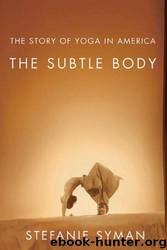The Subtle Body: The Story of Yoga in America by Stefanie Syman

Author:Stefanie Syman [Syman, Stefanie]
Language: eng
Format: epub
Tags: Yoga, Social History, Health & Fitness, History
ISBN: 9780374236762
Google: fFYFEmSVtQAC
Amazon: B003JTHZ16
Publisher: Macmillan
Published: 2010-06-22T10:00:00+00:00
Almost as soon as Watts arrived at the American Academy of Asian Studies, the institute faced financial troubles, and less than a year later, its founding dean, Frederic Spiegelberg, stepped down. Watts took over, running the AAAS out of a rambling manse on Broadway in San Francisco’s Pacific Heights.26
The project was ostensibly to create a sort of information clearinghouse about Asian culture and religion for businessmen, travelers, and others.
The mission Spiegelberg and Watts had in mind was far more ambitious.
“We were concerned with the practical transformation of human consciousness” is how Watts described it, “with the actual living out of the Hindu, Buddhist, and Taoist ways of life at the level of high mysticism.”27
This AAAS was very much in the vein of Pierre Bernard’s International School of Vedic and Allied Research (ISVAR). Both sought to apply yogic knowledge to life and its problems; both subscribed to a more holistic notion of education, putting equal emphasis on theory and practice.
However, the AAAS was far more eclectic in its sources, drawing much from Zen and its Japanese teachers, such as Sabro Hasegawa, a printmaker and disciple of tea master Soshu Sen.
And unlike ISVAR, the American Academy of Asian Studies had enrolled students—and these would come to include beat poets Gary Snyder, who showed up in a black formal suit, complete with a rolled umbrella, and, more occasionally, Allen Ginsberg.28
Although the Korean War and the growing distemper in Vietnam suggested the quite urgent and practical need for some deeper understanding of Asian culture, funding the AAAS was nearly impossible.29
Watts was no good at covert operations or catering to appearances for the sake of the greater mission. As a result, the AAAS “roiled everyone,” including the people who might support it. To burden an academic program with salvific aims was bad enough; to burden it further with Asian techniques, in the early and middle fifties, was dooming it to almost sure failure.30
This in no way seems to have affected the spread of the ideals it stood for.
Once the academy folded in 1956, Haridas Chaudhuri—who had taught Indian philosophy heavily inflected by Sri Aurobindo’s Integral Yoga—set up an urban ashram, where residents could live and meditate.31
Unmoored from an institution of any sort, Watts had to make his way solely through his books and on the lecture circuit.
At this point in his career, Watts wore his hair like a newly minted Mercury 7 astronaut, shaved on the sides, buzzed flat on the top, part of what he called his “square disguise.” He drank more vodka in a day than one man should, smoked like “a paratrooper,” fielded invitations from Columbia, Harvard, Yale Medical School, Cornell, and Rochester, and starred in a nationally broadcast public television show, Eastern Wisdom for Modern Life, which required only that he show up and speak.
Traversing the country, he was a vagabond, a raconteur, a reluctant proselytizer for a philosophy predicated on the impossibility of saying much about it.32
Soon enough, Watts was recognized as one of the country’s foremost experts on Zen, and by some as a defender of “Square Zen,” or the traditional forms of Japanese Zen.
Download
This site does not store any files on its server. We only index and link to content provided by other sites. Please contact the content providers to delete copyright contents if any and email us, we'll remove relevant links or contents immediately.
Tools of Titans by Timothy Ferriss(7831)
Bodyweight Strength Training by Jay Cardiello(7681)
Born to Run: by Christopher McDougall(6902)
Inner Engineering: A Yogi's Guide to Joy by Sadhguru(6455)
Asking the Right Questions: A Guide to Critical Thinking by M. Neil Browne & Stuart M. Keeley(5367)
The Fat Loss Plan by Joe Wicks(4631)
Bodyweight Strength Training Anatomy by Bret Contreras(4482)
Yoga Anatomy by Kaminoff Leslie(4111)
Science and Development of Muscle Hypertrophy by Brad Schoenfeld(3974)
Dynamic Alignment Through Imagery by Eric Franklin(3928)
ACSM's Complete Guide to Fitness & Health by ACSM(3829)
The Four-Pack Revolution by Chael Sonnen & Ryan Parsons(3800)
Exercise Technique Manual for Resistance Training by National Strength & Conditioning Association(3790)
Bodyweight Strength Training: 12 Weeks to Build Muscle and Burn Fat by Jay Cardiello(3786)
Yoga Anatomy by Leslie Kaminoff & Amy Matthews(3745)
The Ultimate Bodybuilding Cookbook by Kendall Lou Schmidt(3715)
Yoga Therapy by Mark Stephens(3577)
Nutrition for Sport, Exercise, and Health by Spano Marie & Kruskall Laura & Thomas D. Travis(3563)
Nutrition for Sport, Exercise, and Health by Marie Spano & Laura Kruskall & D. Travis Thomas(3556)
